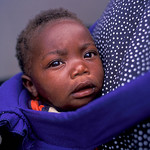 Malaria is a life-threatening disease caused by parasites of the Plasmodium genus that are transmitted to people through the bites of infected mosquitoes. It is a leading cause of childhood morbidity and mortality worldwide, accounting for 7% of deaths in children younger than five years old.
Malaria is a life-threatening disease caused by parasites of the Plasmodium genus that are transmitted to people through the bites of infected mosquitoes. It is a leading cause of childhood morbidity and mortality worldwide, accounting for 7% of deaths in children younger than five years old.
Young children living in stable transmission areas are particularly at risk of malaria, since they have not yet developed protective immunity against the most severe forms of the disease. As clinical outcomes in this group can be poor, there is much interest in understanding what other factors contribute to a poor outcome in order to identify future targets for additional treatments.
Previous data had shown tentative indications that children infected with Plasmodium falciparum malaria had an increased risk of invasive bacterial infection which is one factor that has been associated with a poor outcome. Of the five species of malaria that infect humans, P. falciparum malaria is the most dangerous form, with the highest rate of complications and mortality. There are 300 million cases of infection per year, of which 98% occur in Africa and 70% occur in children aged five years or younger.
 In a new systematic review published in BMC Medicine today, part of the Medicine for Global Health collection, Kath Maitland and James Church now provide definitive evidence that the association between P. falciparum malaria and invasive bacterial infection exists. They have also examined the extent, nature and evidence of this association.
In a new systematic review published in BMC Medicine today, part of the Medicine for Global Health collection, Kath Maitland and James Church now provide definitive evidence that the association between P. falciparum malaria and invasive bacterial infection exists. They have also examined the extent, nature and evidence of this association.
These results have implications for treatment strategies of affected children, which, in turn, has a knock-on effect on other areas. For example, at present, children with severe malaria are treated with routine antibiotics along with anti-malarials. However, this study could lead to revisions of current management guidelines and policy, as it establishes more clearly which children with malaria are more susceptible to a bacterial infection. In addition, the information about the underlying mechanisms could help to tailor antimicrobial management.
The findings from this study won’t only help to improve clinical outcomes for these children, they will have an impact on the use of antibiotics. Targeting antimicrobial strategies to appropriate individuals will lessen indiscriminate use of antibiotics – something which will be helpful in combating the rise of antibiotic resistance, another major concern for health worldwide.
Work in the field of malaria research? Challenges in Malaria Research conference is taking place in September this year and registrations are open. Find out more at www.challenges-in-malaria-research.com
Comments